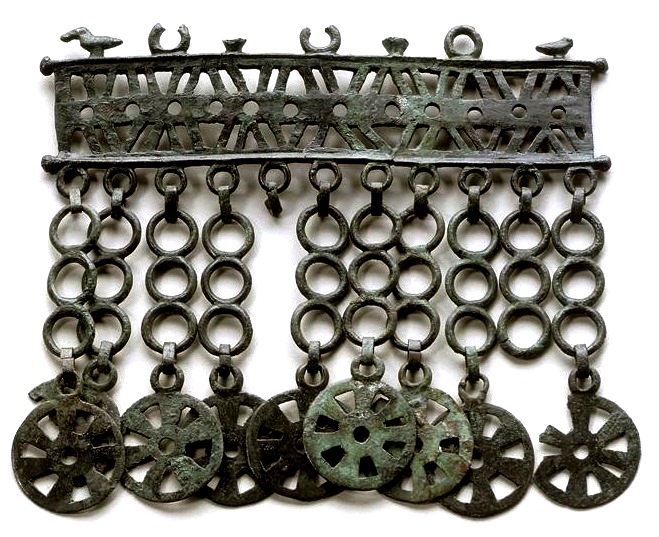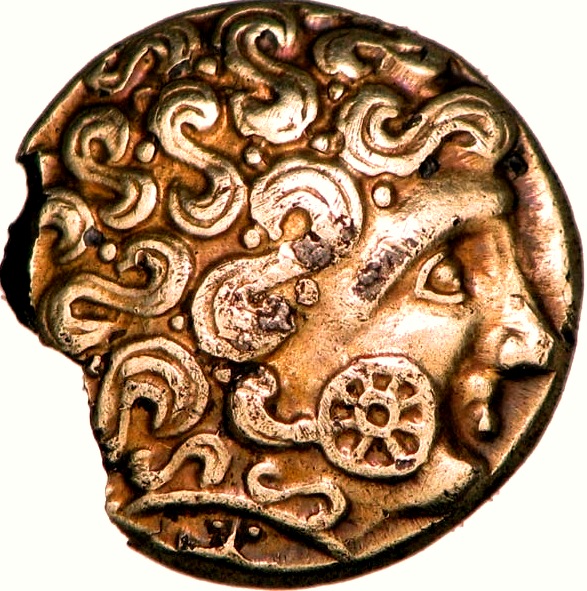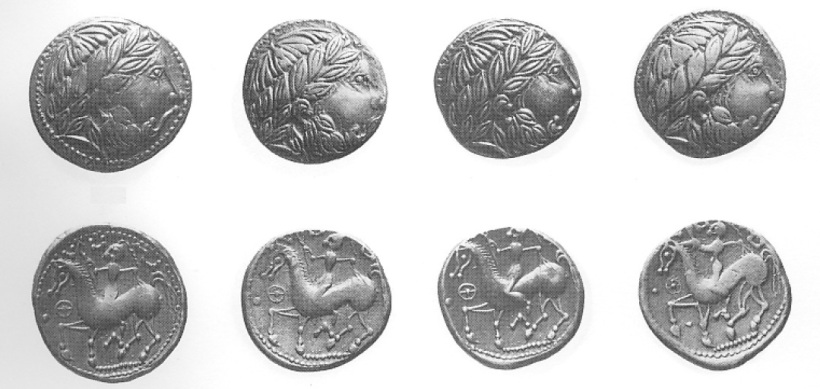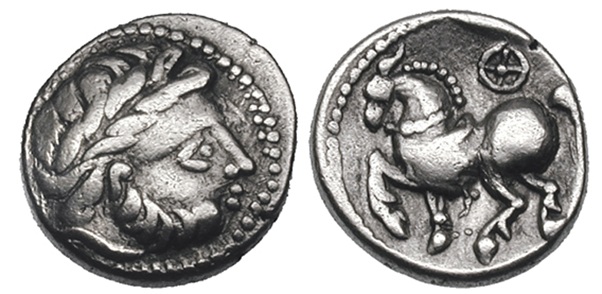UD: Jan. 2019
“And those who pacify with blood accursed
Savage Teutates, Hesus’ horrid shrines,
And Taranis’ altars cruel as were those
Loved by Diana, goddess of the north”.
Lucanus (Pharsalia, Book 1)
The three Celtic deities best known from classical sources are Teutates, Esus, and Taranis. Teutates is identified with Mars or Mercury, and receives as human sacrifice drowned captives and fallen warriors. Esus too is identified with Mercury, but also with Mars, and he accepts as sacrifice prisoners who are hanged on trees and then dismembered.
The Celtic ‘Thunder-God’ – Taranis, who is also known from nine inscriptions found in Italy, Germany, Hungary, Croatia, France and Belgium, and figures as the character of Taran in the Cymric (Welsh) Mabinogi of Branwen ferch Llŷr, is identified with Jupiter, as a warlord and a sky god. Human sacrifices to Taranis were made by burning prisoners (Mac Congail/Krusseva 2010).
Taranis (with wheel and thunderbolt) (0.103 m.)
(Le Chatelet, Gourzon, (Haute-Marne), France)
Noteworthy is the fact that the main Celtic God, Lugh/Lugus, is not mentioned by Lucanus (op cit), leading to the suggestion of Rübekeil (2003:38), in view of his hypothesis of a Celtic origin of the Germanic god Odin, that Lugus refers to the trinity Teutates-Esus-Taranis considered as a single god (Rübekeil L. Wodan und andere forschungsgeschichtliche Leichen: exhumiert, Beiträge zur Namenforschung 38 (2003), 25–42).
Based on writings in the ninth century comment on Lucan, the Berne Scholia, and descriptions in Caesar’s De Bello Gallica, Taranis has been identified as the deity to whom both Julius Caesar and Strabo describe human sacrifices being offered by being burnt alive in ‘wicker men’. The Berne Scholia also describes Taranis as a ‘master of war’, and links him with the Roman deity Jupiter. Taranis’ name is derived from the Proto-Celtic root *torano- ‘thunder’ [Noun] (GOlD: Olr. torann – ‘thunder, noise’ W: MW taran [f] ‘(peal of) thunder, thunderclap’, BRET: OBret. taran gl. tonitru, MoBret. taran [m] CO: OCo. taran gl. tonitruum, MCo. taran).
Jupiter Taranis – Roman era statue of Taranis syncretised with Jupiter, with eagle and solar/Taranis wheel (attributes of the respective deities) in the Musée lapidaire d’Avignon.
The Gaulish word for ‘thunder’ is preserved in the Gasconian dialect of French (taram). The Celtic forms are best explained by a metathesis *tonaro- > *torano-. The unmetathesized form is perhaps attested as the OBrit. Theonym Tanaro and in the old name of the river Po, Tanarus ‘thundering’. (REF: LEIA T-l13, GPC III: 3447, Delamarre 290, Deshayes 2003: 714; See Matasovic R., Etymological Dictionary of Proto-Celtic. Leinen/Boston 2009. P. 384, with relevant lit.).
Fragment of bone with inscription to Taranis in a Celto-Etruscan script, from Tesero di Sottopendonda (Trente) Italy (4/3 c. BC)
THE WHEEL OF TARANIS
Bronze applique, decorated with zoomorphic/bird figures and solar/Taranis wheels, discovered in the Forest of Moidons (Burgandy), France
(6th c. BC)

Stallion with 3 penises, under Taranis wheel – reverse of a Celtic issue of the Tótfalu type from western Hungary (2c. BC)
Associated with the Celtic Thunder God is the Solar Wheel or Wheel of Taranis. The wheel was an important symbol in Celtic polytheism, associated with a specific god, known as the wheel-god, identified as the sky-, sun-, or thunder-god, whose name is attested to as Taranis by Lucanus (op cit). Numerous representations of the Wheel of Taranis are found on coins and other artifacts across Celtic Europe, from Britain in the west to Thrace in the east:
8-spoked votive wheels (rouelles / bronze), thought to correspond to the cult of Taranis. Thousands of such wheels have been found in sanctuaries and other sites across Celtic Europe.
(Musée d’Archéologie Nationale, France)
8-spoked (lead) votive Taranis wheel from the Celtic (Scordisci) settlement at Čurug, Vojvodina Province, Serbia (2-1 c. BC)
Gold beads and pendants, including solar/Taranis wheels, from the Celtic Szárazd-Regöly hoard, discovered in a swamp near Regöly hillfort (Tolna), Hungary
(1st c. BC)
Gaul. Aedui tribe. (Circa 80-50 BC)
AR Quinarius. Helmeted head of Roma left / horse prancing left, Wheel of Taranis below.
Reverse of a Balkan Celtic tetradrachm from central Bulgaria. Note the solar/Taranis wheel in the top left corner.
(1st c. BC)
https://www.academia.edu/6144182/Celtic_Thasos_Type_Coinage_from_Central_Bulgaria
Obverse of a quarter stater of the Caletes tribe with solar/Taranis wheel on the subjects face, discovered at Bordeaux-Saint-Clair (Haute-Normandie), France (1 c. BC)
 Belgic Gaul, Treviri AV Stater. ca. 60–30/25 BC.
Belgic Gaul, Treviri AV Stater. ca. 60–30/25 BC.
Celticized horse rearing left, in upper field star, V with dotted border, & cross with four annulets between arms, pellet-cross under belly, star under tail; Wheel of Taranis, two stars & globule in front, above a row of pellets, herringbone pattern, solid line above which three stars.
THUNDER ON THE BALKANS
In southeastern Europe a range of Celtic artifacts have also been found which depict the Wheel of Taranis. The Celtic deity holding the solar wheel is represented, for example, on Plate C of the Gundestrup Cauldron thought to have been produced by the Thraco-Celtic Scordisci tribes in northwestern Bulgaria in the late 2nd c. BC. Artifacts depicting the Wheel of Taranis in this region range from Celtic coins dating from the 3rd c. BC onwards, to Romano-Celtic artifacts from the same region dating to the 3rd/4th c. AD.
Taranis with Wheel as depicted on plate C of the Gundestrup cauldron
In the 20’s of the 2nd c. BC the Scordisci tribe in Thrace came under attack from the north. An expansion of the Germanic Cimbri tribe was finally repulsed near the Celtic settlement of Singidunum (Belgrade), and the Cimbri migrated further west (Rankin D. Celts and the Classical World. New York 1987:19 ). It is likely that it was during these events that the most famous of Scordisci treasures, the Gundestrup cauldron, was looted and carried off by the Cimbri (Bergquist A.K., Taylor T.F. The Origin of the Gundestrup Cauldron, Antiquity, vol. 61, 1987. 10-24).
See also:
https://balkancelts.wordpress.com/2012/05/12/the-scordisci-wars/
Celtic tetradrachms from the Ribnjacka Hoard (Bjelovar, Croatia) – 2nd / 1st c. BC. Note the Wheel of Taranis in front of the horseman on the reverse. A large number of tetradrachms found in this hoard bore the symbol of the Taranis Wheel (Nos. 45 – 64).
(After Kos P., Mirnik I. The Ribnjacka Hoard (Bjelovar, Croatia). In The Numismatic Chronicle 159 (1999)
Celtic belt buckle of the Laminci type with Taranis Wheel from Dalj, eastern Croatia (1 c. BC)
https://balkancelts.wordpress.com/2014/08/14/a-taranis-belt-buckle-from-dalj-eastern-croatia/
Scordisci AR Drachm. Dachreiter type. Serbia/Bulgaria (2/ 1 c. BC)
Laureate head right / Horse trotting left. Wheel of Taranis above
Evidence for the worship of Taranis across Europe, and the depiction of the Solar Wheel associated with this Celtic deity on coins and other artifacts, is particularly important as it again illustrates that although regional differences existed between the pan-Celtic peoples in terms of material culture, certain core religious beliefs and iconography were shared, and remained constant despite temporal and geographic dispersion.
Mac Congail
















